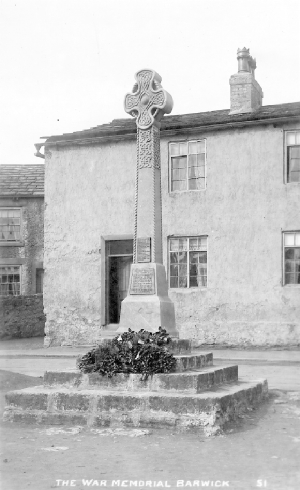A Summary of the Parish
A Summary of the Parish
At the outbreak of the Great War, on 4 August 1914, Barwick in Elmet and Scholes were typical rural villages on the edge of a big city. Scholes had been a village mainly built on agriculture and much of the land where the heart of the village stands now, along Station Road and Main Street was farmland with the odd house or terrace of houses here and there. The names common in the village at the time of the Great War and before the major expansion of the village in the 1920s and 1930s, were names that had been in the village for hundreds of years, and the same can be said of Barwick. In Scholes at the end of the 19th Century, the village was widely but thinly spread. The Station, linking Scholes to Wetherby to the north and Leeds to the east via a southerly route through Cross Gates, had tied cottages for its signalman and platelayer (later the tenancy was taken by the station porter). Much of the lower portion of the village was given over to farming and there were two farms opposite each other on Main Street a little way along from Scholes Hall and Mr Shippen’s Beer shop, Scholes Lodge Farm, and Green Lodge Farm. People as far away as Whinmoor, Seacroft, the Manstons, and Barnbow classed themselves as Scholes people and when war came, they too joined the boys from the village proper. Few of the men listed on the Scholes war memorial for the Great War of 1914 - 1919 are mentioned as living in Scholes at the time of the 1911 census, which shows how people were still coming to live in Scholes, either from elsewhere in the country, to escape from the unhealthy miasma of industrial Leeds or to take up tenancies on the land. Then as now, people were prepared to move great distances in the search for work.
Barwick was (and still is) a village of ancient origin proud
of its Maypole, topped with a silver fox weathervane at just over 86ft above
the road surface it is the tallest in England. As in Scholes, the population of
Barwick, in the old Kingdom of Penda's Elmet, was a stable one. Again, names in
1914 merely marked the current generation of ancient families who had worked
the same fields, milled the same grain, forged the same ironwork, or cut the
same coal. Often there could be half a dozen households where different
branches of the same wider family lived, half streets were made up of cousins
all bearing the same surnames. The influx of people into Scholes was not as
pronounced in Barwick, possibly due to it not having the railway station. Many more of the men remembered on Barwick's war
memorial are listed on the 1911 census.
Whenever Barwick is spoken of or written about, the word ancient is never far from the topic. Barwick can boast evidence of human habitation from the Iron Age having the remains of a complex hill fort to the north of the centre of the village. There is also the Norman Motte in the southern end of the hill fort and the true scale of the prehistoric earthworks is difficult to appreciate without the luxury of an aerial photograph.
During the Great War, the twin villages in the parish gave up almost two hundred of their sons to serve the Country. Many more who had been born in the villages but had moved away also served, and some names of Scholes and Barwick men appear on war memorials near and far. The centre of Barwick today is a scene that the men who left for the Great War would recognise, a few colour changes here and there, a better road surface and straighter rooflines, but the sinews that bind the village together are unchanged. The Maypole is still as brightly decorated, the church and Methodist chapel, the school, the pubs, Hall Tower Hill, and the land, all the same.
By the time the Second World War broke out people had been expecting war for months, if not years. The appeasement policy of the League of Nations in answer to Hitler and his Third Reich’s aggressive expansion was failing and his march south and east went on without hindrance. While this would have been a major topic for discussion in the villages, the major concern immediately prior to the war was the gruesome discovery of the head and two limbs belonging to a young woman on the edge of Legatt’s Wood which was on Leeds Road between the railway and the top of the hill. A murder hunt was launched in an operation involving both the West Riding Police and the Leeds City Police and co-ordinated from a temporary incident room set up in the Barleycorn Inn, a few hundred yards away across the fields. Despite the efforts of the two police forces and the assistance of 15 police chiefs who had visited the scene, it was not until 29th April 1940 that a suspect was charged with the ‘Wilful Murder’ of 20-year-old Ethel Wraithmell. Railway Telegraphist, Wilfred Lowe was tried for the murder and acquitted on 16th July 1940. He was, however, found guilty of manslaughter and sentenced to a year’s imprisonment. By this time both Scholes and Barwick had each lost a man to the war.


